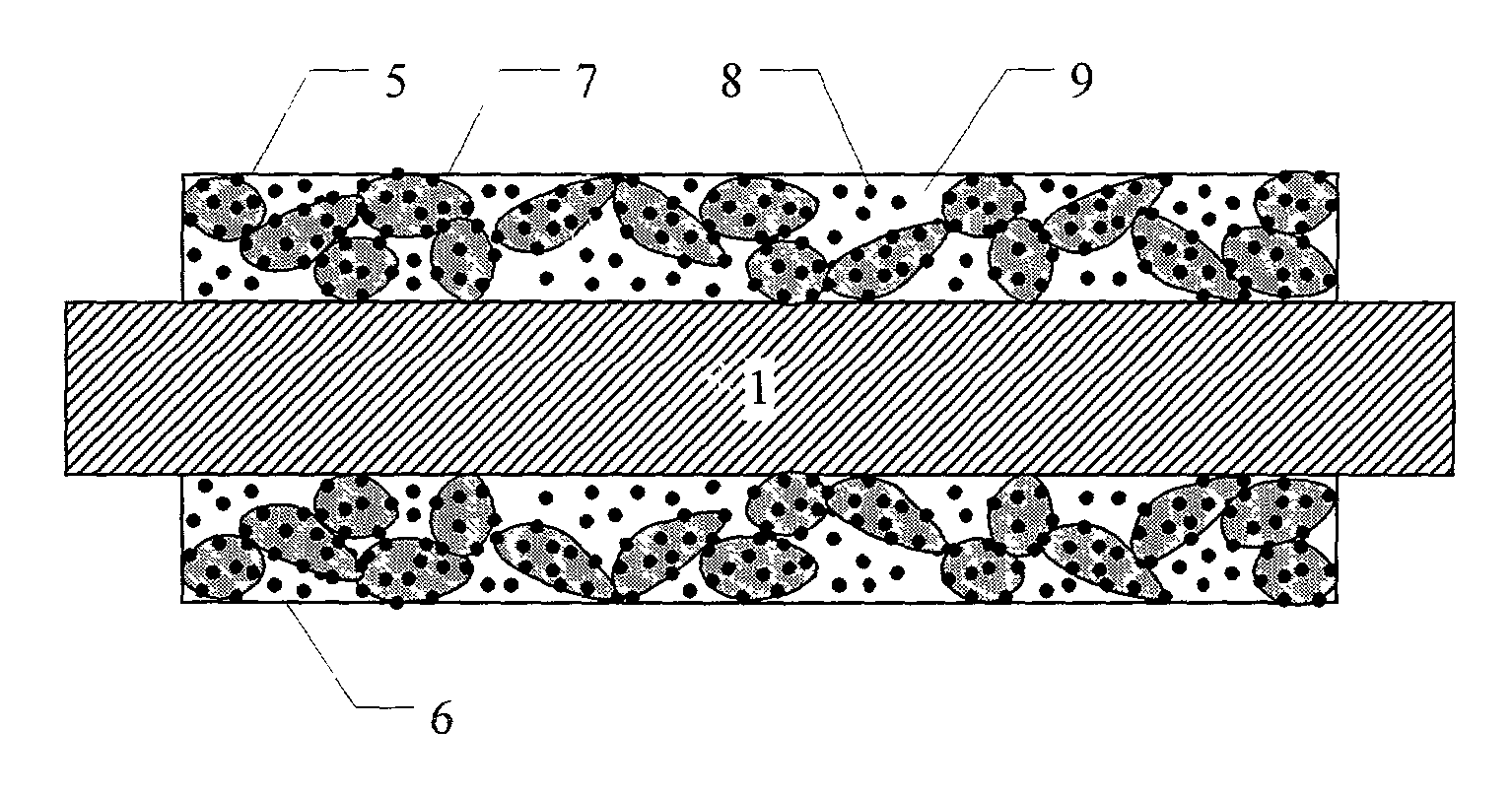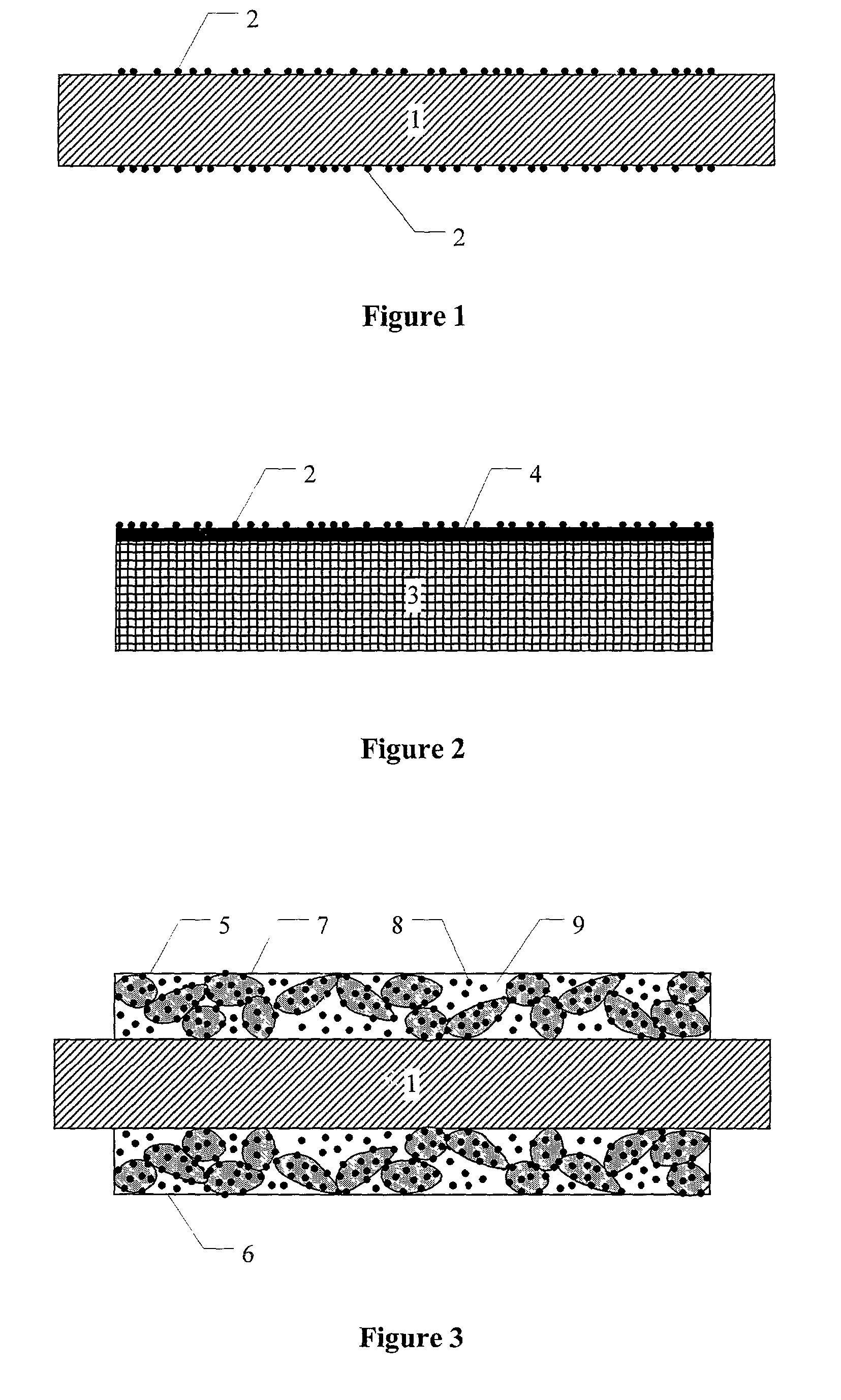Noble metal nanoparticles, a process for preparing these and their use
- Summary
- Abstract
- Description
- Claims
- Application Information
AI Technical Summary
Benefits of technology
Problems solved by technology
Method used
Image
Examples
example 1
[0051] a) Preparing Pt Nanoparticles
[0052] 11.1 g of a solution of bis(ethanolammonium) hexahydroxoplatinate (Pt content 9 wt. %; total chlorine content <100 ppm; from dmc.sup.2, Hanau) were added dropwise to 1.5 l of fully deionized water in which 1.0 g of gum arabic (Merck) had previously been dissolved. Then, 1 l of ethanol was added with stirring and the resulting mixture was heated, wherein the mixture turned black. The solution was kept under reflux for one hour at 85.degree. C. and then concentrated to a volume of 100 ml by evaporation. The colloidal solution prepared in this way had a pH value of 5.9 and contained 10 g Pt / l (1 wt.% Pt) and 10 g / l (1 wt. %) of the stabilizer gum arabic. The ratio of Pt nanoparticles to stabilizer was thus 1:1. The total chlorine content of the solution was less than 10 ppm. The average size of the Pt particles was determined using TEM (transmission electron microscopy) and was 2 nm.
[0053] b) Catalyzing Ionomer Membranes
[0054] 5.6 g of the col...
example 2
[0058] a) Preparation of Pt / Ru Nanoparticles
[0059] 7.28 g of a solution of bis(ethanolammonium) hexahydroxoplatinate (Pt content 9 wt. %; total chlorine content <100 ppm; from dmc.sup.2, Hanau) and 2.265 g of a solution of ruthenium nitrosylnitrate (Ru content 15 wt. %, total chlorine content <200 ppm; from dmc.sup.2, Hanau) were added dropwise to 1.5 1 of fully deionized water, in which 1.0 g of gum arabic (Merck) had been dissolved. Then 1 l of ethanol was added with stirring and the resulting mixture was heated, wherein it turned black. The solution was held under reflux for one hour at 85.degree. C. and then concentrated by evaporation to a volume of 100 ml. The colloidal solution obtained in this way had a pH value of 5.7 and contained 10 g PtRu / l (1 wt. % PtRu, atomic ratio 1:1) and 10 g / l (1 wt. %) of the stabiliser gum arabic. The ratio of PtRu nanoparticles to stabilizer was thus 1:1. The total chlorine content of the solution was less than 50 ppm. The average size of the P...
example 3
[0062] 2.22 g of a solution of bis(ethanolammonium) hexahydroxoplatinate (Pt content 9 wt. %; total chlorine content <100 ppm; from dmc.sup.2, Hanau) were added dropwise to 1.5 l of fully deionized water in which 0.2 g of Kelzan (xanthan gum, Lubrizol-Langer, Bremen) had previously been dissolved. Then 1 l of isopropanol was added with stirring and the resulting mixture was heated, wherein it turned black. The solution was held under reflux for one hour at 85 .degree. C. and then concentrated by evaporation to a volume of 100 ml. The colloidal solution obtained in this way had a pH value of 5.6 and contained 2 g Pt / l (0.2 wt. % Pt) and 2 g / l (0.2 wt. %) of the stabilizer Kelzan. The ratio of Pt nanoparticles to stabilizer was thus 1:1. The total chlorine content of the solution was less than 30 ppm. The average size of the Pt particles was determined by TEM and was 2.5 nm.
[0063] An ionomer membrane was catalyzed in the same way as described in example 1 and a membrane with a total p...
PUM
| Property | Measurement | Unit |
|---|---|---|
| Fraction | aaaaa | aaaaa |
| Angle | aaaaa | aaaaa |
| Percent by mass | aaaaa | aaaaa |
Abstract
Description
Claims
Application Information
 Login to View More
Login to View More - R&D
- Intellectual Property
- Life Sciences
- Materials
- Tech Scout
- Unparalleled Data Quality
- Higher Quality Content
- 60% Fewer Hallucinations
Browse by: Latest US Patents, China's latest patents, Technical Efficacy Thesaurus, Application Domain, Technology Topic, Popular Technical Reports.
© 2025 PatSnap. All rights reserved.Legal|Privacy policy|Modern Slavery Act Transparency Statement|Sitemap|About US| Contact US: help@patsnap.com



